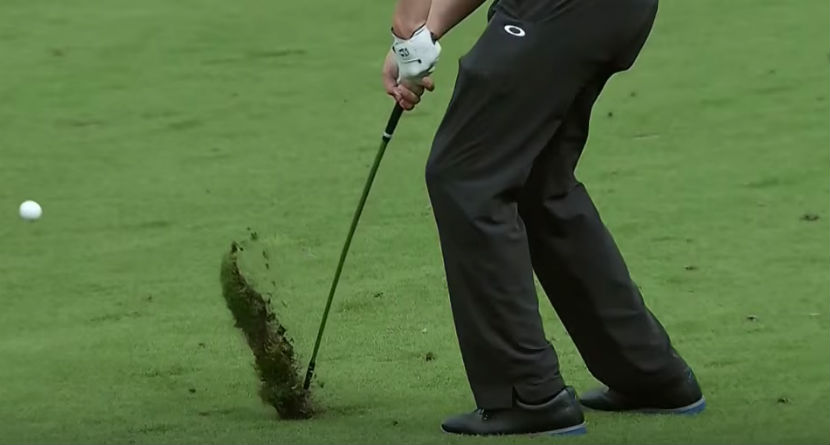Instruction
Golf 101: Why do I chunk it?

Whether you are a beginner, 10 handicaps, or Rory McIlroy, no one player is immune to the dreaded chunk. How many times have you hit a great drive, breathing down the flag from your favorite yardage and laid the holy sod over one? It’s awful and can be a total rally killer.
So what causes it? It could be several things, for some players, it could be a steep angle of attack, others, early extension and an early bottoming out and sometimes you’ve just had too many Coors Lights and the ground was closer than your eyes told you…been there.
This is Golf 101—let’s make it real simple and find one or two ways that a new golfer can self diagnose and treat themselves on the fly.
THE MAIN CAUSE
With beginners I have noticed there are two main things that cause the dreaded chunk:
- Players stand too close to the ball and have no way to get outta the way on the way down. This also really helps to hit Chunk’s skinny cousin: Skull.
- No rotation in any form causing a steep angle of attack. You’ve seen this, arms go back, the body stays static, the club comes back down and sticks a foot in the ground.
SO HOW DO I FIX MYSELF?
Without doing all-out brain surgery, here are two simple things you can do on the course (or the range) to get that strike behind the ball and not behind your trail foot.
This is what I was taught when I was a kid and it worked for years.
- Make baseball swings: Put the club up and in front of your body and make horizontal swings paying close attention to accelerating on the way through. After a few start to bend at the hips down and down until you are in the address position. This not only gives your body the sensation of turning but reorientates you to exactly where the bottom of your arc is.
- Drive a nail into the back of the ball: This was a cure-all for me. Whether I had the shanks, chunks, skulls, etc, focusing on putting the clubhead into the back of that nail seemed to give me a mental picture that just worked. When you are hammering a nail into a wall. you focus on the back of that nail and for the most part, hit it flush 9 outta 10 times. Not sure if its a Jedi mind trick or a real thing, but it has gotten me outta more pickles than I care to admit.
As you get better, the reason for the chunk may change, but regardless of my skill level, these two drills got me out of it faster than anything all while helping encourage better fundamentals. Nothing wrong with that.
- LIKE60
- LEGIT11
- WOW0
- LOL0
- IDHT0
- FLOP2
- OB2
- SHANK7
Instruction
Clement: Laid-off or perfect fade? Across-the-line or perfect draw?

Some call the image on the left laid off, but if you are hitting a fade, this could be a perfect backswing for it! Same for across the line for a draw! Stop racking your brain with perceived mistakes and simply match backswing to shot shape!
- LIKE0
- LEGIT0
- WOW0
- LOL0
- IDHT0
- FLOP0
- OB0
- SHANK1
Instruction
The Wedge Guy: The easiest-to-learn golf basic

My golf learning began with this simple fact – if you don’t have a fundamentally sound hold on the golf club, it is practically impossible for your body to execute a fundamentally sound golf swing. I’m still a big believer that the golf swing is much easier to execute if you begin with the proper hold on the club.
As you might imagine, I come into contact with hundreds of golfers of all skill levels. And it is very rare to see a good player with a bad hold on the golf club. There are some exceptions, for sure, but they are very few and very far between, and they typically have beat so many balls with their poor grip that they’ve found a way to work around it.
The reality of biophysics is that the body moves only in certain ways – and the particulars of the way you hold the golf club can totally prevent a sound swing motion that allows the club to release properly through the impact zone. The wonderful thing is that anyone can learn how to put a fundamentally sound hold on the golf club, and you can practice it anywhere your hands are not otherwise engaged, like watching TV or just sitting and relaxing.
Whether you prefer an overlap, interlock or full-finger (not baseball!) grip on the club, the same fundamentals apply. Here are the major grip faults I see most often, in the order of the frequency:
Mis-aligned hands
By this I mean that the palms of the two hands are not parallel to each other. Too many golfers have a weak left hand and strong right, or vice versa. The easiest way to learn how to hold the club with your palms aligned properly is to grip a plain wooden ruler or yardstick. It forces the hands to align properly and shows you how that feels. If you grip and re-grip a yardstick several times, then grip a club, you’ll see that the learning curve is almost immediate.
The position of the grip in the upper/left hand
I also observe many golfers who have the butt of the grip too far into the heel pad of the upper hand (the left hand for right-handed players). It’s amazing how much easier it is to release the club through the ball if even 1/4-1/2″ of the butt is beyond the left heel pad. Try this yourself to see what I mean. Swing the club freely with just your left hand and notice the difference in its release from when you hold it at the end of the grip, versus gripping down even a half inch.
To help you really understand how this works, go to the range and hit shots with your five-iron gripped down a full inch to make the club the same length as your seven-iron. You will probably see an amazing shot shape difference, and likely not see as much distance loss as you would expect.
Too much lower (right) hand on the club
It seems like almost all golfers of 8-10 handicap or higher have the club too far into the palm of the lower hand, because that feels “good” if you are trying to control the path of the clubhead to the ball. But the golf swing is not an effort to hit at the ball – it is a swing of the club. The proper hold on the club has the grip underneath the pad at the base of the fingers. This will likely feel “weak” to you — like you cannot control the club like that. EXACTLY. You should not be trying to control the club with your lower/master hand.
Gripping too tightly
Nearly all golfers hold the club too tightly, which tenses up the forearms and prevents a proper release of the club through impact. In order for the club to move back and through properly, you must feel that the club is controlled by the last three fingers of the upper hand, and the middle two fingers of the lower hand. If you engage your thumbs and forefingers in “holding” the club, the result will almost always be a grip that is too tight. Try this for yourself. Hold the club in your upper hand only, and squeeze firmly with just the last three fingers, with the forefinger and thumb off the club entirely. You have good control, but your forearms are not tense. Then begin to squeeze down with your thumb and forefinger and observe the tensing of the entire forearm. This is the way we are made, so the key to preventing tenseness in the arms is to hold the club very lightly with the “pinchers” — the thumbs and forefingers.
So, those are what I believe are the four fundamentals of a good grip. Anyone can learn them in their home or office very quickly. There is no easier way to improve your ball striking consistency and add distance than giving more attention to the way you hold the golf club.
More from the Wedge Guy
- The Wedge Guy: Golf mastery begins with your wedge game
- The Wedge Guy: Why golf is 20 times harder than brain surgery
- The Wedge Guy: Musings on the golf ball rollback
- LIKE87
- LEGIT13
- WOW6
- LOL1
- IDHT0
- FLOP4
- OB1
- SHANK8
Instruction
Clement: Stop ripping off your swing with this drill!

Not the dreaded headcover under the armpit drill! As if your body is defective and can’t function by itself! Have you seen how incredible the human machine is with all the incredible feats of agility all kinds of athletes are accomplishing? You think your body is so defective (the good Lord is laughing his head off at you) that it needs a headcover tucked under the armpit so you can swing like T-Rex?
- LIKE0
- LEGIT2
- WOW2
- LOL0
- IDHT0
- FLOP0
- OB0
- SHANK2
-

 19th Hole2 weeks ago
19th Hole2 weeks agoDave Portnoy places monstrous outright bet for the 2024 Masters
-

 19th Hole4 days ago
19th Hole4 days agoJustin Thomas on the equipment choice of Scottie Scheffler that he thinks is ‘weird’
-

 19th Hole2 weeks ago
19th Hole2 weeks agoTiger Woods arrives at 2024 Masters equipped with a putter that may surprise you
-

 19th Hole4 days ago
19th Hole4 days ago‘Absolutely crazy’ – Major champ lays into Patrick Cantlay over his decision on final hole of RBC Heritage
-

 19th Hole2 weeks ago
19th Hole2 weeks agoTwo star names reportedly blanked Jon Rahm all week at the Masters
-

 19th Hole1 week ago
19th Hole1 week agoReport: LIV Golf identifies latest star name they hope to sign to breakaway tour
-

 19th Hole2 weeks ago
19th Hole2 weeks agoNeal Shipley presser ends in awkward fashion after reporter claims Tiger handed him note on 8th fairway
-

 19th Hole1 week ago
19th Hole1 week agoBrandel Chamblee has ‘no doubt’ who started the McIlroy/LIV rumor and why

















Bob Jones
Oct 23, 2020 at 12:52 pm
Two other causes are playing the ball forward of the natural bottom of the swing, and having the arms underextended at address–the momentum of the forward swing straightens them out and the clubhead runs out of room before it gets to the ball.
geohogan
Oct 15, 2020 at 9:36 am
A chip or pitch involves a backswing and through swing, as one continuous motion
whereas in baseball they are two separate motions.
Two motions with sufficient time between, can be consciously controlled.
Chipping and pitching in golf, one or the other can be consciously controlled, not both.
G
Sep 30, 2020 at 9:42 am
I think it’s important to note that a while a “baseball swing” can be a good training drill, the player must make sure that, unlike a baseball swing, they must transfer their weight forward through the swing. I’ve played with many baseball/softball players over the years and they struggle to get their weight transferred off their back foot and having your weight on your back foot is another cause of chunks (and often pulls/hooks).